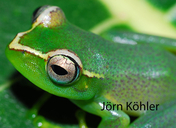|
Boophis baetkei Köhler, Glaw & Vences, 2008
Subgenus: Boophis | family: Mantellidae subfamily: Boophinae genus: Boophis |
| Species Description: Koehler J, Glaw F, Vences M 2008 Two additional treefrogs of the Boophis ulftunni species group (Anura: Mantellidae) discovered in rainforests of northern and south-eastern Madagascar. Zootaxa 1814:37-48 | |
 © 2015 Jörn Köhler (1 of 2) |
|
|
|
Description In life this species exhibits translucent green coloration around the dorsal surface of the head and body. Small reddish and purplish dots are evenly distributed on the flanks, upper limb surfaces, and dorsum. A pinkish golden stripe runs from the snout along the canthus to the upper eyelid, over the eye and above the tympanum and fades at midbody. The head stripe is bordered by a dark red line that turns purplish dorsolaterally to tympanum. The head stripe is also bordered by red spots posteriorly. Heel and knee have pinkish golden flecks encircled by reddish brown. Dorsal parts of fingers and toes are colored yellowish green, with green discs and yellowish green webbing. Ventral surfaces of limbs look translucent bluish green, chest turquoise green, and throat yellowish green. Belly is white and bones are bluish green. Iris appears mainly silvery grey with fine brown spotting and reticulation. Posterior part of iris has a black peripheral arc followed by light blue. Dorsally, the eye periphery itself also has some black (Kohler et al. 2008). In preservative Boophis baetkei assumes a creamy yellow color on both dorsal and ventral surfaces. Small pink spots are scattered regularly around upper surface of head, dorsum, and upper surfaces of limbs. A pink stripe runs along the tip of the snout to the upper eyelid and fades at the urostyle (Kohler et al. 2008). Boophis baetkei is distinguished from members of the B. albilabris and B. microtympanum species groups by a green translucent shade in life (versus opaque green) and smaller size. It differs from species in the B. rappiodes and B. mandraka species groups in having a pigmented ventral side (vs. transparent ventral skin and visible inner organs in those species groups). In contrast to B. ulftunni, B. baetkei has larger males (30.8 vs. 21-24 mm SVL), more extensive toe webbing, lacks reddish brown markings and has a gray iris with brown spots and reticulation (vs. bicolored iris with outer gold ring and inner purple ring in B. ulftunni). Compared to B. lilianae, B. baetkei shows the presence of distinct patches of vomerine odontophores, a larger tympanum, and a rounded snout in dorsal view (vs. mucronate snout in the male holotype of B. lilianae and truncate snout in the female holotype of B. lilianae) (Kohler et al. 2008; Wollenberg et al. 2008). Distribution and Habitat Country distribution from AmphibiaWeb's database: Madagascar
Life History, Abundance, Activity, and Special Behaviors Trends and Threats Possible reasons for amphibian decline General habitat alteration and loss Comments
References
Glaw, F., and Vences, M. (2006). A Field Guide to the Amphibians and Reptiles of Madagascar, 3rd Edition. Vences & Glaw Verlag GbR, Köln. Kohler, J., Glaw, F., and Vences, M. (2008). ''Two additional treefrogs of the Boophis ulftunni species group (Anura: Mantellidae) discovered in rainforests of northern and south-eastern Madagascar.'' Zootaxa, 1814, 37-48. Wollenberg, K. C., Andreone, F., Glaw, F., and Vences, M. (2008). ''Pretty in pink: A new treefrog species of the genus Boophis from north-eastern Madagascar.'' Zootaxa, 1684, 58-68. Originally submitted by: Henry Zhu (first posted 2008-10-17) Edited by: Kellie Whittaker (2008-11-14) Species Account Citation: AmphibiaWeb 2008 Boophis baetkei <https://amphibiaweb.org/species/7146> University of California, Berkeley, CA, USA. Accessed May 28, 2025.
Feedback or comments about this page.
Citation: AmphibiaWeb. 2025. <https://amphibiaweb.org> University of California, Berkeley, CA, USA. Accessed 28 May 2025. AmphibiaWeb's policy on data use. |



 Map of Life
Map of Life